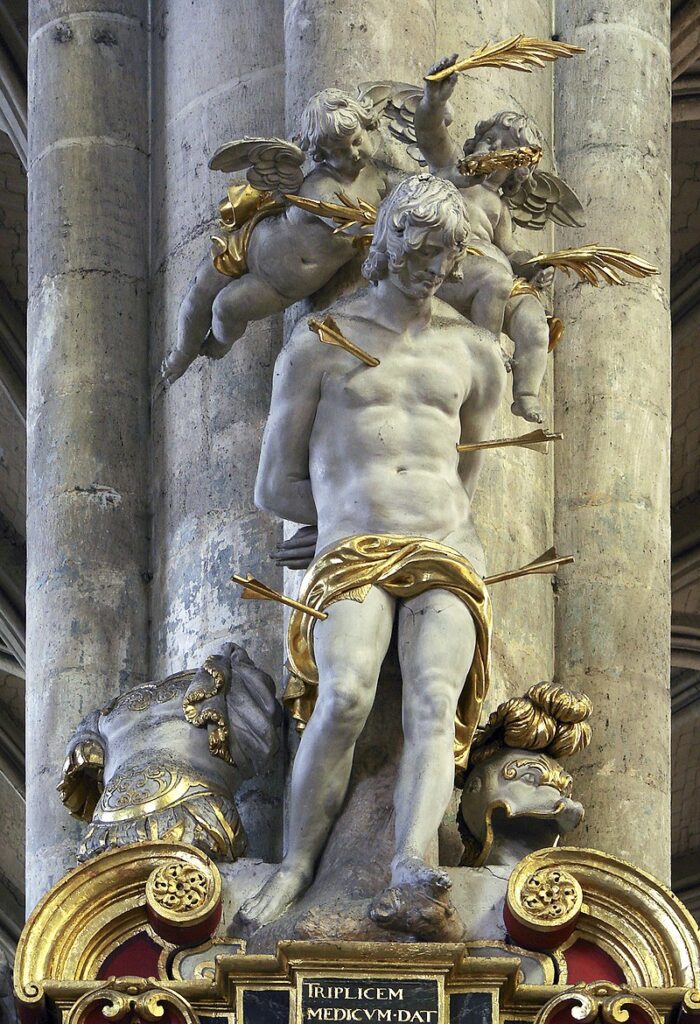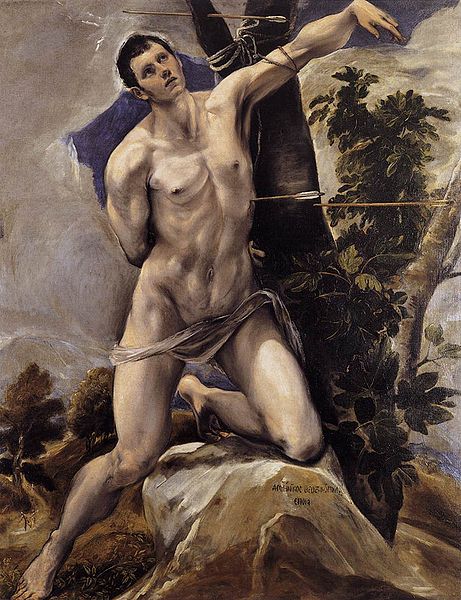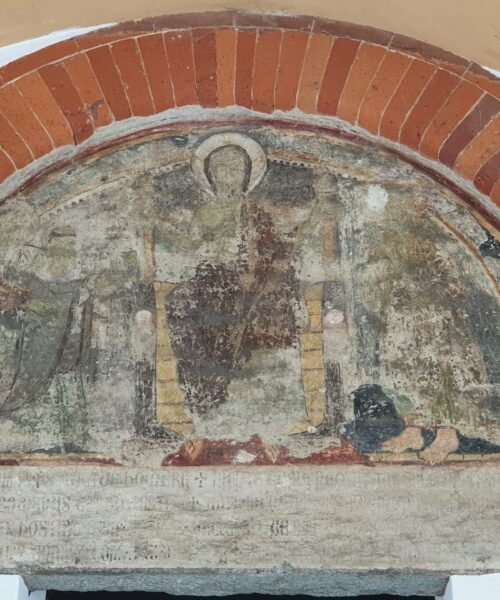On a cold January day, when the sky casts a gray hue over the world, the Church’s memory wraps itself around the figure of Saint Sebastian, a saint who, like a tragic hero of ancient memory, stands tall in the history of art as an enigma as captivating as it is mysterious. His image, so frequently depicted in artworks, has transcended centuries, transforming into an icon that defies time and conventions.
In the oldest depictions, Saint Sebastian appears as a soldier, clad in military cloak, a tangible reminder of his earthly past and sacrifice. However, it’s during the Renaissance that his image undergoes a remarkable metamorphosis: from a dressed soldier to an almost naked martyr, his pale skin pierced by arrows, an image that evokes both pain and beauty.
This change isn’t merely an artistic whim but reflects a profound shift in the perception of the human body, a return to the Apollonian beauty celebrated by the classics. Renaissance artists, influenced by humanism and the rediscovery of antiquity, began to celebrate the human body in all its forms, finding in Saint Sebastian a perfect subject to express this new vision.
The arrows piercing him become not just a symbol of his martyrdom but also a metaphor for a beauty that transcends pain, a bridge between the divine and the human, between suffering and ecstasy. Thus, over the centuries, Saint Sebastian becomes an icon, a subject that attracts artists of every era and style.

In one of his most famous works, Giovanni Ambrogio de Predis presents us with a clothed Saint Sebastian, who almost resembles a prince, portrayed in a way that distills his essence into a pure form, without the accompaniment of a landscape context. This artistic choice focuses attention on the saint himself and the symbols surrounding him.
In this depiction, Saint Sebastian appears clothed, a nod to his earthly life before martyrdom. The choice to portray him in refined garments, rather than naked and pierced by arrows as commonly seen in many Renaissance works, imparts a sense of dignity and strength, perhaps echoing the image of Gian Galeazzo Maria Sforza, as some scholars have suggested. This interpretation emphasizes the saint’s noble sacrifice, presenting him as a stoic hero rather than a figure of suffering.

Moving to Nicolas Blasset and his sculpture in the Cathedral of Amiens, we find a stark contrast. Here, Blasset chooses to immortalize Saint Sebastian in the midst of his martyrdom, capturing the emotional intensity of that pivotal moment. The statue, rich in detail and almost tangible tension, seems to depict the saint in a moment of connection between the earthly and the divine, suspended in a balance between human suffering and spiritual serenity.
These two representations, while different in form and expression, both speak to the complexity and depth of Saint Sebastian’s character, highlighting how each artist interprets the saint through their unique creative and cultural filter. In both, there is an intense exploration of the themes of sacrifice and transformation, elements that make Saint Sebastian such a powerful and multifaceted figure in art.

The visions of Saint Sebastian offered by Marco Palmezzano and Pietro Perugino, as well as El Greco’s interpretation, stand out for how each artist has rendered the martyr’s figure, infusing their works with unique emotional and stylistic nuances.
Marco Palmezzano presents us with a Saint Sebastian set against a backdrop of classical ruins, a clear homage to the influence of Mantegna. This historical context, evocative of a glorious past now in ruins, provides a stark contrast to the figure of the martyr, highlighting the theme of transience and the transition from pagan to Christian values. Palmezzano’s work, dated around 1530, uses oil and tempera on wood, typical techniques of the Renaissance period, to create an image that is both classical and emotionally charged.

Pietro Perugino‘s tempera is a magnificent example of Renaissance mastery in harmonizing ideal human forms with religious symbolism. Saint Sebastian, in the midst of his martyrdom, stands with a superhuman grace, his limbs posed in a manner reminiscent of classical statuary. The choice of colors, from the pale purple of the loincloth contrasting with the greens and blues of the landscape, emphasizes the solemnity of the moment. The archers, dressed in vivid colors, enliven the scene without detracting from the central figure. Striking is Sebastian’s calm, his serene eyes turned heavenward, almost symbolizing a sublime acceptance of his fate. This representation is not mere visual narrative; it’s a meditation on faith, pain, and redemption, executed with a precision that transcends time and space, inviting us to reflect on our own experience of the divine.
This refined tempera work is enriched with gold details, a technique that adds a sense of preciousness and sacredness to the image, typical of the devotional art of the period. The folio demonstrates Perugino’s ability to combine technical mastery with intense emotional expressiveness.

El Greco, with his “Martyrdom of Saint Sebastian,” painted between 1576 and 1579, offers an even more dramatic and intense interpretation. El Greco, with his late Renaissance style influenced by Italian training, depicts Saint Sebastian in an unusual posture, kneeling rather than upright, bound to a tree with a rope wrapping an uplifted arm. This unique pose, along with the stormy landscape in the background, painted with free and gestural brushstrokes, adds extraordinary emotional intensity. The saint’s eyes are directed toward heaven, in a gesture that could be interpreted as communion with God or acceptance of his imminent death. This Saint Sebastian by El Greco, though slightly elongated, appears fully physical and earthly, a depiction of the human body in all its solidity and vulnerability.

Finally, a 15th-century anonymous representation of the Martyrdom of Saint Sebastian exemplifies the artistic tradition of the late Middle Ages, where the martyr is often depicted in the midst of his torment. The emphasized dimensions and proportions, along with the vividness of the colors and the gilding of the background, are typical of this period. The figure of Saint Sebastian is central, with his slender and delicate body offering a stark contrast to the archers, depicted in saturated colored clothes and expressive faces. There’s an almost theatrical aura to the work, with attention to narrative details like the instruments of torture and the posture of the executioners, highlighting the drama of the scene and amplifying the viewer’s compassion towards the saint.
In these representations of Saint Sebastian, a narrative unfolds that goes beyond the visible, a dialogue that extends from the canvas’s confines to the soul’s depths. Each artist, with brushstrokes, chisel, or ink, has transcribed not just the story of a martyr but also a reflection on the human condition, the meaning of sacrifice, and the quest for transcendence. The saint, in his silent eloquence, stands as a mirror of the ages, witnessing the changing artistic sensitivities and spiritual understanding. These works, in their variety and beauty, are not just testimonials of a bygone era, but are open dialogues, still vibrant, inviting us to consider our own experience of pain and hope, of the earthly and the eternal.












